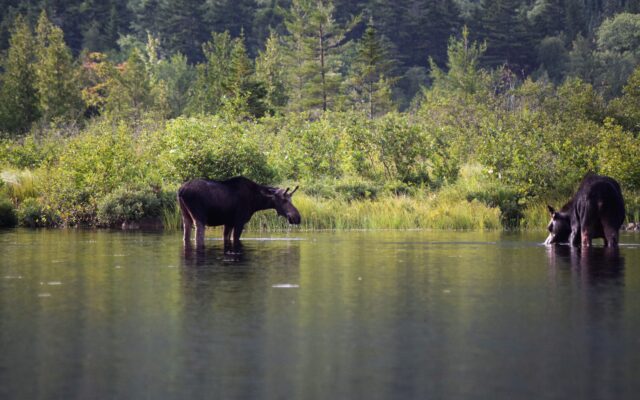
This Maine town is where you want to go for moose sightings
By Nick Thomas
As our summer in Maine winds down and we continue our photographic quest for moose while exploring the state, we recently stumbled on the captivating village of Kokadjo (pronounced co-CAD-jo) on the eastern side of Moosehead Lake.
The term “village” here is quite an embellishment, as the hospitable sign shortly after crossing the Roach River bridge amusingly clarifies. In fact, we were told the current population hovers somewhere between four and six.
From Greenville, our northbound journey to Kokadjo involved a leisurely 25-minute drive along paved Lily Bay Road, guided by the reassuring presence of moose warning signs that dotted the way. Lily Bay State Park lies about halfway between Greenville and Kokadjo and is a great place to stop for a few hours, with the easy two-mile Shoreline Trail providing excellent vistas of Moosehead Lake.

MOOSE SIGHTING — Two moose seen in the morning near Kokadjo on the eastern side of Moosehead Lake
Shortly after passing the park at around 2 p.m., we spotted our first moose of the trip, leisurely strolling across the road. Such encounters are quite frequent along this route, we were told, and it’s a good idea for passengers to have cameras in hand given that these sizable creatures can swiftly vanish into the surrounding foliage as vehicles approach.
Kokadjo lies at the north end of 3,300-acre First Roach Pond with excellent fishing for coldwater game fish (apparently, there’s also Second, Third, Fourth, Sixth, and Seventh Roach Ponds, but oddly no Fifth).
Buildings are sparse in Kokadjo with several weathered structures that are likely remnants of a bygone farm era. There are also seven fully equipped modern log cabins for rent that line the waterfront.
The Kokadjo Trading Post & Convenience Store on the other side of the road provides food, souvenirs and supplies for visitors.

MOOSE IN THE BOG — A moose near Lazy Tom Bog just after sunset.
A curious sign on the Trading Post warns visitors of both the resident dog and owner!
Proceeding north from Kokadjo, the paved road soon turned to dirt but remained easily navigable. After about a mile, we reached a fork and turned left onto Spencer Bay Road where we soon came upon an area known as the Lazy Tom Bog, reportedly a hot spot for sighting moose feeding on reeds at sunrise and dusk.
Just after the bridge at the bog, on the right, is a parking area, popular with moose spotters and anglers casting their lines into the waters beneath the bridge. But despite multiple trips to the picturesque area during the day and evening, our efforts to spot moose there remained unrewarded.
Dodging the occasional passing logging truck (which always hold the right of way), we continued on Spencer Bay Road for another mile or two, coming to another boggy area on the left. Although we visited several times without sighting any moose, we arrived one evening after sunset and spotted a large cow moose feeding despite the rapidly fading light.

WELCOME — The welcome sign in Kokadjo with First Roach Pond in the back.
While I have come to the conclusion that photographing moose might best be left to the professionals, the Kokadjo deer proved more cooperative. We saw many grazing in the shrubs along Lily Bay Road throughout the day. In one instance, we pulled over to see a white-tailed deer about 10 feet away that just stared at us for about a minute until a logging truck zoomed past.
With many lakes and ponds, large and small, dotting the area, we decided to try moose-spotting from a canoe early one morning. From the far side of the shore, we observed two moose feeding, a cow and presumably her young bull calf. It was an image I had envisioned for some time — moose leisurely foraging in a serene lake, framed by the grandeur of Maine’s majestic mountains merging with a silhouetted tree line.
As we quietly paddled closer — mindful of the moose’s acute sense of hearing — we were able to maintain a distance of about 300 feet without distressing the animals. Notwithstanding a wobbly canoe and my rather modest telephoto lens, I was able to snap the best moose images so far during our summer in Maine.
Thomas teaches at Auburn University at Montgomery in Alabama and has written features, columns and interviews for numerous publications. He is visiting the University of Maine this summer and traveling the state with his wife, Debby.